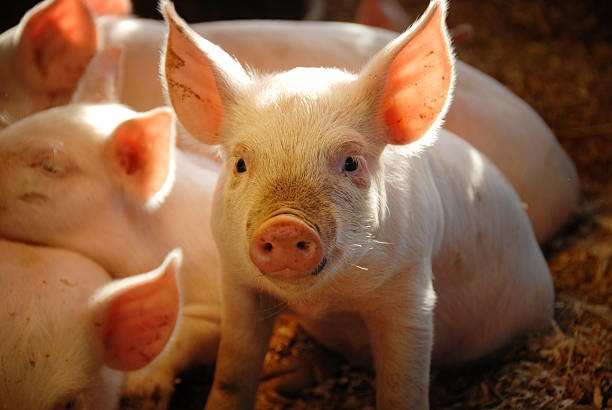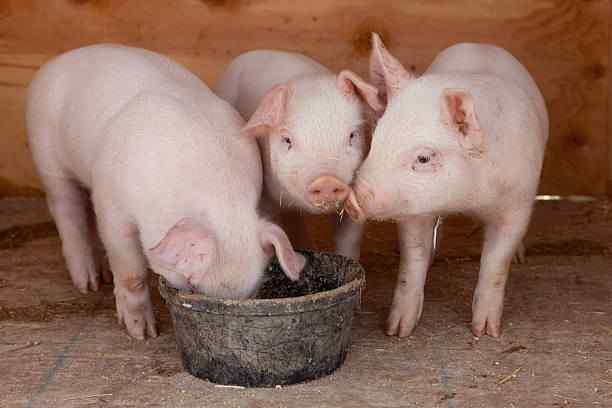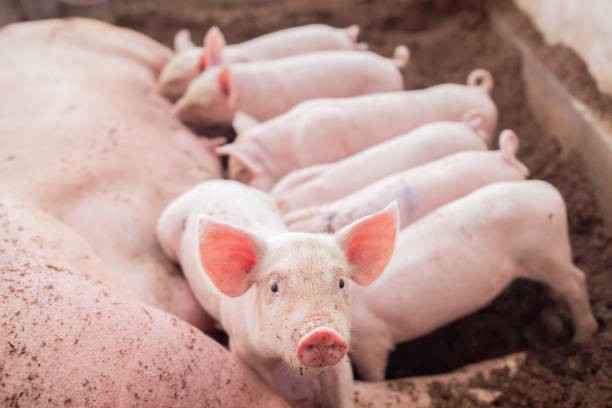How Many Piglets Can a Pig Have?

Whether you are about to start a pig farm or just interested in pig reproduction, something that may pop in your mind is, “How many piglets can a pig have?” Efficient management of pigs requires that one knows the average litter size alongside other traits that can affect the production of piglets. In this guide, we will provide all necessary information regarding litters, beginning with their averages and maximums and concluding with factors and best practices to enhance breeding.
Average Litter Size: How Many Piglets Do Pigs Have?
Typically, a well-nourished and managed adult female pig, or sow, will yield 10–12 piglets per litter. This number can change based on factors like the genetic traits of the pig, the particular breed, the health conditions of the sow, her age, and how well she is cared for.
Some breeds of sows are known to give birth to litters of 15–20 piglets. Although such large numbers do occur, they are rare, and the mortality rate is much higher.
Typical Litter Size by Breed
- Large White (Yorkshire): 10–14 piglets
- Landrace: 11–15 piglets
- Duroc: 8–12 piglets
- Berkshire: 6–10 piglets
- Hampshire: 8–12 piglets
- Tamworth: 6–9 piglets
Factors That Influence Litter Size
1. Breed and Genetics
Breeds like Yorkshire and Landrace have high reproductive performance. Yorkshire and Landrace not only exhibit higher reproductive performance, but also genetic predisposition affects litter size and even the overall health of the piglets. The choice of sows and boars with good reproductive history significantly improves productivity.
2. Age of the Sow
- First litter gilts (young females): Smaller litters of around 6–8 piglets.
- Mature sows (2nd to 5th parity): Peak fertility and often 10–15 piglets.
- Older sows (post 6th parity): Declining litter size along with reproductive efficiency.
3. Health and Nutrition
A healthy diet and nutritional well-being are vital to one’s health. Inadequate intake of some essential vitamins, minerals, and calories may lower fertility and reduce litter size. Disease or stress can have adverse effects on gestation and fetal as well as postnatal growth in pigs.
4. Breeding Management
- Insemination timing: Well-planned insemination increases the chances of conception and improves the number of piglets littered.
- Fertility of boar: Active, fertile boars ensure better conception rates and increased offspring.
- AI: Provides greater control of the genetics and timing of births, leading to the possibility of increased litter size if well managed.
5. Environmental Conditions
Overheating, as well as overcrowding and inadequate hygienic practices, may be counterproductive for both fertility and embryonic survival.
6. Parity (Number of Previous Births)
Sows tend to peak in productivity between the third and fifth litters. Controlling sow replacement strategies based on parity helps sustain production efficiency.
Pig Gestation and Farrowing
Pregnancy Duration
For pigs, the pregnancy duration is around 114 days, which can be conveniently referred to as “3 months, 3 weeks, and 3 days.”
Signs of Impending Farrowing
- Nesting behavior
- Swollen vulva
- Milk let-down 24 hours before birth
- Restlessness and reduced appetite
Farrowing Process
Usually farrowing takes 2 to 4 hours. Since the duration of each stage in farrowing ranges between 15 and 20 minutes, piglets will be born consecutively in intervals of 15 to 20 minutes. Some action should be taken if a considerable amount of time has elapsed without a birth or if there are some indications of trouble.
Maximizing Litter Size and Piglet Health

Best Practices
- Genetic Selection: Select breeds and lines that are popular for high-volume litters.
- Sow Management: Track their health status, nutrition, and body weight.
- Vaccination & Parasite Control: Protect herd health to lower the chance of complications during pregnancy.
- Precision Feeding: Adapt nutrition at different stages of reproduction.
- Effective Breeding Programs: Track estrus cycles and carry out artificial insemination at the right times.
- Reduce Stress: Ensure ease and little manipulation during the period of gestation.
Weaning and Beyond
In commercial systems, piglets are usually weaned at 3 to 4 weeks of age. Good practices during weaning help the sow recover and get ready for the next breeding cycle.
How Many Piglets Can a Pig Have in the World?
With regard to how many piglets a sow can have, this is entirely dependent on the genetics, nutrition, health, and management of the animal. Provided the conditions are right, sows can give birth to more than 20 piglets, which increases the global average litter size range of 8 to 12 piglets. In fact, the largest recorded litter was 37 piglets born to a Large White sow in the United Kingdom in 1999.
Generally, a pig will give birth to 6 to 8 piglets in the first litter. This is dependent on the breed, genetics, age, and health of the pig. Gilts tend to have smaller litters as compared to mature sows, and they tend to have greater litter sizes in subsequent pregnancies. With adequate care and nutrition, some breeds may have up to 10 piglets in the first litter.
How Many Times Can a Pig Get Pregnant in a Year?
On average, a pig can get pregnant 2 to 2.5 times in a year. This is possible because a pig’s gestation period is approximately 114 days (3 months, 3 weeks, and 3 days). Sows can produce 2 full litters a year, and in well-managed farms, some get a third litter. Breed, health, recovery period, and farm management all affect reproduction frequency within a year. Effective breeding programs focus on the greatest outcome while still ensuring the sow’s welfare.
How Many piglets Can a Pig Have In A Lifetime?
The average pig and sow breed can give birth to around 100 to 200 piglets, depending on her breed, age, and health. Every sow can produce 2 litters every year, yielding about 8 to 12 piglets per litter. With good commercial management, sows are bred for about 4-6 years, which leads to an average of 8-12 litters within their reproductive lifespan. Alongside proper nutrition and care, good breeding management encourages maximum piglet lifetime production.
At What Age Can a Pig Get Pregnant?
A female pig, known as a gilt, becomes capable of getting pregnant from 5 to 6 months of age. This is an estimate because a gilt’s sexual maturity is influenced by genetics, health, and the breed. Nevertheless, it is usually best to wait until the gilt is about 8 months old and fully weighs between 100 and 120 kg (220–265 lbs). In order to avoid complications during the first trimester. With proper timing, pig farming becomes more productive with improvement in litter size, reduction of complications, and multi-term productivity.
A pig does not take very long to give birth, with the average time falling within the 2 to 5 hour range, spread out between 15 to 20 minute intervals for each piglet. This is known as farrowing, and in most cases the sow’s health, the farrowing conditions, and the number of piglets will determine how long it will take. In certain scenarios, however, farrowing can last for upwards of 8 hours, mostly due to large litters. Veterinary assistance is required if there is more than 30-45 minutes of waiting time between piglets, or the time exceeds 6 hours.
How Many Piglets Can a Wild Pig Have?
The average wild pig, or wild boar/feral hog, is able to give birth to 4 to 8 piglets each cycle. However, these numbers may shift depending on the sow’s condition, age, health, habitat, and nutrition. Under optimal circumstances, certain wild pigs are capable of having over 10 piglets. In many areas, wild pigs tend to reproduce once or twice a year, which is one of the main reasons their populations are increasing so quickly.
How Many Babies Normally Can an Adult Pig Have?
An adult pig or sow normally farrows (gives birth to) 10 to 12 piglets, although it depends on the individual’s age, health, and breed. Some breeds, such as Yorkshire or Landrace, are highly productive and can yield up to 15 or more piglets. With good management and breeding, a Yorkshire sow would be able to give at least 20 to 30 piglets per annum by having 2 to 2.5 litters in a year.

Things That Affect How Many Babies a Pig Has
Key factors affecting the number of piglets produced are breed and genetics, the age of the sow, nutrition, overall health, and breeding management. Breeds with high fertility, such as Landrace or Yorkshire, increase litter size with proper feeding, disease control, and optimal breeding timing. Breeding management technique can also hinder survival and stamina in pigs due to poor care.
How To Make Sure Your Pigs Have More Babies
To ensure your pigs produce more offspring, select high-fertility breeds such as Yorkshire or Landrace, ensure proper nutrition, breed during the right season, and ensure a stress-free, sanitary environment. Employ healthy, genetically superior boars or AI, maintain sows at a body condition score that is optimal, and have a regular vaccination and deworming schedule. Monitor performance records and cull low-producing sows to optimize litter size and piglet survival.
Conclusion:
In conclusion, the average number of piglets born from a single sow ranges from 8 to 12, although some hyperprolific breeds may exceed 15 to 20 under optimal circumstances. With attentive care regarding their diets and breeding schedules, sows can achieve multiple large litters each year, thus optimizing productivity in pig farming. The astonishing potential for reproduction in pigs is highlighted by the existing world record of 37 piglets born in a single birth. For effective planning, breeding, and management in pig farming, understanding the number of piglets per litter is crucial.
Frequently Asked Questions:
Q1: What is the maximum number of piglets a pig can give birth to?
The maximum number of piglets that a pig can give birth to in a single litter is by far the highest record. However, the average is still capped at around 12, especially for older pigs.
Q2: How many piglets can a pig make?
Various breeds of pigs are associated with births of 8 up to 20 per litter, with some separating themselves from the pack and giving up to 37.
Q3: How many piglets can a pig have in India?
In India a pig can give birth to 6 to 12 piglets a litter on average. Commercial breeds such as Large White Yorkshire are even better and sustain higher outputs if well managed on farms.
Q4: How many hours from the first piglet to the last does a sow take when giving birth?
A sow usually gives birth to the first to the last piglet within a window of 2 to 5 hours, with each piglet being born about 15-20 minutes apart. If labor goes beyond 6 hours, or if there is a plateau in progress, veterinary intervention may be necessary.
Q5: What is the maximum litter number for pigs?
The world record maximum litter size of a sow giving birth to piglets stands at an astonishing 37 piglets. Generally, the average litter size for most swine is 8 to 12 piglets, contingent upon the breed and overall health.
Q6: What is the largest litter of piglets ever recorded?
The largest litter recorded so far was from a Chinese sow in 2019 that gave birth to 34 piglets. This is, however, extremely uncommon.
Q7: How often can a pig have litters?
With good management, a sow can have 2 to 2.5 litters in a single year.
Q8: Can pigs give birth without human assistance?
Yes, most sows have the ability to farrow on their own, but help is beneficial if there are problems.
Q9: Do all piglets in a litter survive?
No, Sadly, the pre-weaning mortality rate sits at an average of 10% to 20%, so a significant portion does not survive due to management factors.
10) What causes a pig to produce few piglets?
A pig may have a smaller litter size because of inadequate nutrition, genetic reasons, poorly timed breeding, health complications, advanced age, environmental factors, or poor fertility from the boar. Good husbandry practices, a well-balanced diet, and a lack of diseases help maximize pig litter size.



